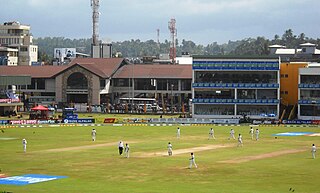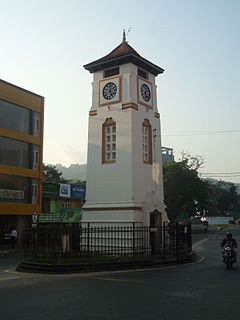This article may need to be rewritten entirely to comply with Wikipedia's quality standards.(May 2009) |
| Thelikada | |
|---|---|
| Village | |
 |
Thelikada is a rural village situated in Galle District, in the southern part of Sri Lanka.

Galle is a district in Southern Province, Sri Lanka. It is one of 25 districts of Sri Lanka, the second level administrative division of the country. The district is administered by a District Secretariat headed by a District Secretary appointed by the central government of Sri Lanka.

Sri Lanka, officially the Democratic Socialist Republic of Sri Lanka, is an island country in South Asia, located in the Indian Ocean to the southwest of the Bay of Bengal and to the southeast of the Arabian Sea. The island is historically and culturally intertwined with the Indian subcontinent, but is geographically separated from the Indian subcontinent by the Gulf of Mannar and the Palk Strait. The legislative capital, Sri Jayawardenepura Kotte, is a suburb of the commercial capital and largest city, Colombo.
The Gin River (Gin Ganga) flows near the village. Also the Gin Dam (Bund) is lying inside the village. The Wakwella Bridge (Wakwalla Palama) is nearby.
Wakwella Bridge is a bridge situated in Galle District near Thelikada, Sri Lanka. It is around 152.5 m (500 ft) long and crosses the Gin River. Built on the Gin Ganga Dam, the bridge links the villages of Kudagoda and Gonapura. It was constructed in 1999 and at the time was the longest bridge in the country.
Thelikada is situated 116 km (72 mi) away from the capital Colombo. It is a 2.30 hours drive from the Capital. Access points to the village from Galle Road are Hickkaduwa, Rathgama, Boossa, Pintaliya, Gintota and Galle.

Colombo is the commercial capital and largest city of Sri Lanka. According to the Brookings Institution, Colombo metropolitan area has a population of 5.6 million, and 752,993 in the city proper. It is the financial centre of the island and a popular tourist destination. It is located on the west coast of the island and adjacent to the Greater Colombo area which includes Sri Jayawardenepura Kotte, the legislative capital of Sri Lanka and Dehiwala-Mount Lavinia. Colombo is often referred to as the capital since Sri Jayawardenepura Kotte is within the urban area of, and a suburb of, Colombo. It is also the administrative capital of the Western Province and the district capital of Colombo District. Colombo is a busy and vibrant place with a mixture of modern life and colonial buildings and ruins. It was the legislative capital of Sri Lanka until 1982.

There are over 2,000 residents in the village. Thelikada Sunandaramaya is an old temple which can be seen some old drawings over 100 years old Wall painting. Also there is a school called Thelikada Maha Vidyalaya. Currently there are over 300 students and 30 teachers. Thelikada Post Office, Sanasa Bank, and Thelikada Police station provide services to the village.
Since the nineteenth century, brickmaking has been a key local industry although today its importance has declined with sand mining replacing it to a degree. Another important economic activity is agriculture, with cultivation of rubber, coconut, tea, cinnamon and rice.

A brick is building material used to make walls, pavements and other elements in masonry construction. Traditionally, the term brick referred to a unit composed of clay, but it is now used to denote any rectangular units laid in mortar. A brick can be composed of clay-bearing soil, sand, and lime, or concrete materials. Bricks are produced in numerous classes, types, materials, and sizes which vary with region and time period, and are produced in bulk quantities. Two basic categories of bricks are fired and non-fired bricks.

Agriculture is the science and art of cultivating plants and livestock. Agriculture was the key development in the rise of sedentary human civilization, whereby farming of domesticated species created food surpluses that enabled people to live in cities. The history of agriculture began thousands of years ago. After gathering wild grains beginning at least 105,000 years ago, nascent farmers began to plant them around 11,500 years ago. Pigs, sheep and cattle were domesticated over 10,000 years ago. Plants were independently cultivated in at least 11 regions of the world. Industrial agriculture based on large-scale monoculture in the twentieth century came to dominate agricultural output, though about 2 billion people still depended on subsistence agriculture into the twenty-first.

The coconut tree is a member of the palm tree family (Arecaceae) and the only living species of the genus Cocos. The term "coconut" can refer to the whole coconut palm, the seed, or the fruit, which botanically is a drupe, not a nut. The term is derived from the 16th-century Portuguese and Spanish word coco meaning "head" or "skull" after the three indentations on the coconut shell that resemble facial features.












